|
|
|
 |
|
|
|
|
|
No21: Formerly A.A. Savill & Son
|
|
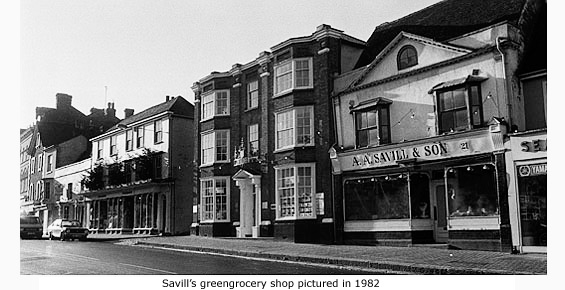
Built c.1780, this property is now a listed building. In 1887 it was owned by the Marsh family, pawnbrokers and cabinet makers, and when Mr Marsh retired the pawnbroker's licence was bought by Alfred Slapps Barrett. He was so strongly opposed to people pledging their possessions that the licence was never used again in Bishop's Stortford.
The shop later became Mr Hunwick's drapers shop and then the International Grocery & Tea shop. In the latter half of the 20th century it was a greengrocers owned and run by A A Savill & Son. Closure in the mid 1980s was largely due to the rising popularity of supermarkets and high rents asked by landlords, the same factors that contributed to the closure of many other general shops in North Street at that time. These included a grocery store, Butchers, Bakers, Chemists, Newsagents and Sweet shop. When Savill's ceased trading the shop became, for a short while, the Gaddis restaurant. North Street is now populated mainly by banks and estate agents – one of the latter currently occupying these premises.
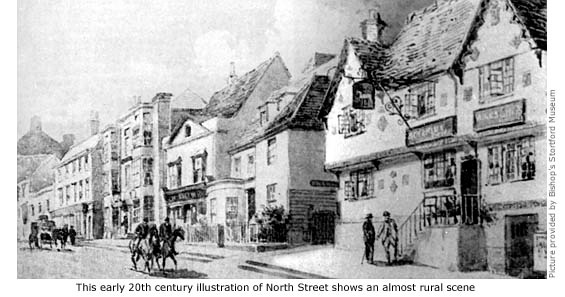
|
|
|
|
No 19: Sworders (The Chequers Hotel)
|
|
This Grade II listed building first opened in 1684 as a coaching and posting house. In 1721 the owner was S Warren (a baker) and in 1729 it was called the Bell Inn. Whether or not it was the Chequers before becoming the Bell Inn is hard to determine, but later renovation work revealed a chequers drawing on a 17th century beam. In 1764 it was owned by a man named White and around 1788, while in the ownership of his grand daughter, it was called (or renamed) the Chequers. Local brewers Hawkes took possession in 1791, adding the late Georgian facade, and after extensive modernisation in 1874 it became the very popular Chequers Hotel.
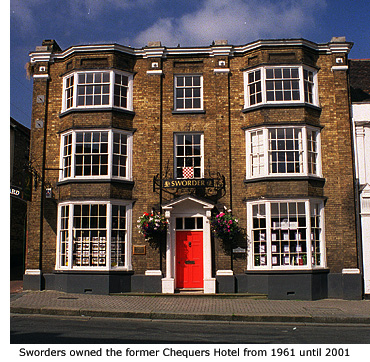 The name and sign 'Chequers' apparently originated in ancient Rome: a chequer board outside a bar indicating that banking services were also provided. The checked board was used to aid counting and is the origin of the word 'exchequer.' Appropriately, the Chequers was used as an Excise Office in 1867. Now a Grade II listed building, the inside still retains some fine 17th century work. The name and sign 'Chequers' apparently originated in ancient Rome: a chequer board outside a bar indicating that banking services were also provided. The checked board was used to aid counting and is the origin of the word 'exchequer.' Appropriately, the Chequers was used as an Excise Office in 1867. Now a Grade II listed building, the inside still retains some fine 17th century work.
During the 1800s the hotel made additional money by keeping several horses and hiring them out to local services such as Mail, Fire, and Funeral Directors, each of whom found it un-economical to keep and stable their own. In May 1929 a fire in Chequers Yard, at the rear of the building, destroyed a garage containing 26 cars and workshops and warehouses belonging to Henry Sparrow, as well as ancient stables. Although these were replaced and stabling and accommodation was still provided here until 1950, the new stable block was demolished in 1986.
The hotel's popularity soared after the arrival of the railway in 1842, even though competition was rife between local innkeepers and hoteliers to accommodate the many visitors to the town. It certainly stole the advantage in the early 1900s by having its own omnibus attend the arrival and departure of every train at the railway station. This convenience certainly made it popular with parents whose sons boarded at the college. The hotel also boasted a long assembly room, often used by Bishop's Stortford's Masonic lodge before they acquired their own premises in Hadham Road (See Guide 5).
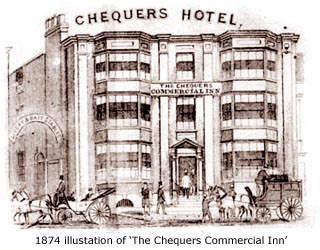 A meeting in the hotel shortly after it opened in 1874 led to the formation of Bishop's Stortford Football Club; their first match being played two weeks later against the East of England Nonconformist Grammar School - now the Bishop's Stortford College. Between 1903 and 1939 the club used the Falcon public house at Dane Street as their headquarters, but in 1939 re-adopted the Chequers and stayed until after the war when their own club house was built at Rhodes Avenue. A meeting in the hotel shortly after it opened in 1874 led to the formation of Bishop's Stortford Football Club; their first match being played two weeks later against the East of England Nonconformist Grammar School - now the Bishop's Stortford College. Between 1903 and 1939 the club used the Falcon public house at Dane Street as their headquarters, but in 1939 re-adopted the Chequers and stayed until after the war when their own club house was built at Rhodes Avenue.
A frequent passer-by of the town in the late 1800s was the Prince of Wales – later Edward VII (1901–1910) – on his way to visit Lady Brooke (later the Countess of Warwick) at her home, Easton Lodge, near Dunmow. The Prince usually took the train from London to Bishop’s Stortford and then used the branch line to reach her house (See Guide 11 – Branch Line), but if the weather was fine he would employ Chequer's coachman Charles Clark to drive him there.
In residence here between 1903 and 1946 was the hotel’s most popular and renowned landlord, Joe Brazier. He became something of a national celebrity in 1931 when local artist John Kynnersley Kirby exhibited a painting at the Royal Academy of Art of Joe standing at the hotel's entrance with his pet dog, Pat. Entitled ‘The Landlord of the Chequers’ the artist later gave the painting to Mr Brazier as a gift. True to form he then hung it in the ‘Brazier Room’ – a room inside the hotel that held mementos of his life – and charged the public an entrance fee to see it.
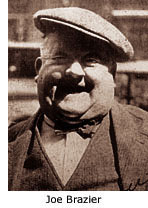 Joe Brazier was born in 1873 at the Bricklayers Arms public house in Hadham Road. His father, Robert, was licensee at the time and Joe later succeeded him. In his youth he was a keen athlete and cyclist and at one time worked for Great Eastern Railways. He married in 1896. His prosperity in later years enabled him to buy property and land in and around the town, some of which he farmed, but he was also benevolent. In 1919, he more or less gave Bishop's Stortford football club the land at Rhodes Avenue on which their first home ground was established. Joe Brazier was born in 1873 at the Bricklayers Arms public house in Hadham Road. His father, Robert, was licensee at the time and Joe later succeeded him. In his youth he was a keen athlete and cyclist and at one time worked for Great Eastern Railways. He married in 1896. His prosperity in later years enabled him to buy property and land in and around the town, some of which he farmed, but he was also benevolent. In 1919, he more or less gave Bishop's Stortford football club the land at Rhodes Avenue on which their first home ground was established.
He was a member of Bishop's Stortford Urban Council for 33 years and its chairman in 1933, the same year in which, as a member of the National Farmers Union, he went as part of a delegation to South Africa. He was also a district councilor from 1918 to 1938 and member of the Guardians committee. Joe celebrated his Golden wedding anniversary in 1946 and after 44 years as landlord of the Chequers, retired in 1947. He died in February 1948, aged 75, at the George Hotel
When the Chequers finally closed in 1961 the occasion was marked by a funeral wake, celebrated by some of the many sporting organisations that previously had their headquarters here. G E Sworder subsequently took over the buiding, converting it into offices and lowering the doorway to street level. They remained in residence for the next forty years, but in February 2001 the firm's long association with the town finally ended when they sold their Property Management Services and estate agents wing to current owners, FPDSavills. MORE PICTURES
|
|
|
|
No17: Pearsons
|
|
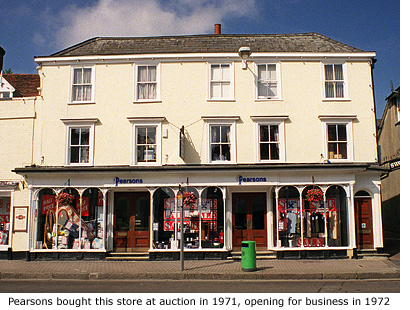 This early 18th century building was built as two properties, a fact not easily recognised at ground level because of the large shop frontage with original Victorian ironwork and two separate entrances. It is more apparent from the photograph on the left – the right-hand side of the building noticeably larger with six upstairs windows, and the dividing wall between the two properties falling roughly where the sign is placed between windows on the first floor. Until the turn of the 19th century the larger part of this building was the White Lion Inn and stands on the site of a 17th century inn going by the same name. Churchwardens' accounts of 1681 record that Elizabeth Phillips paid rent of 1d for the White Lion in Northstrete [sic]. This early 18th century building was built as two properties, a fact not easily recognised at ground level because of the large shop frontage with original Victorian ironwork and two separate entrances. It is more apparent from the photograph on the left – the right-hand side of the building noticeably larger with six upstairs windows, and the dividing wall between the two properties falling roughly where the sign is placed between windows on the first floor. Until the turn of the 19th century the larger part of this building was the White Lion Inn and stands on the site of a 17th century inn going by the same name. Churchwardens' accounts of 1681 record that Elizabeth Phillips paid rent of 1d for the White Lion in Northstrete [sic].
Also recorded is a rather amusing story. On one occasion the local justice of the peace, Dr Yardley (d.1697), had been disturbed by rowdiness coming from the White Lion. When he entered the premises, all those present rose and stood with their hats off except one, John Bangham, who was apparently the main cause of the trouble. Although he remained seated the barmaid Ann Almond affirmed he was not drunk, which seems to have made his rudeness even worse. Unfortunately the outcome of the incident isn't recorded.
Despite occasional rowdiness, the inn must have been of some importance because it was mentioned in Carey’s Travelling Companion and Patterson’s Road Book – both famous directories of the time. The original inn is also thought to have been home to the town's postmaster, mentioned in 1699 (See Guide 13 – Post Office). Previous ownership of No 17 North Street is sketchy but the following is recorded: John and Martha Reeve 1711–1725; Thomas Harvey (no date); William Clark (victualler) 1769; Mary Lord (nee) Searle inherits from William Clark deceased, 1771; Nathaniel Smith Machin, stated as tenant (no date).
The White Lion finally ceased trading in 1800. Mary Lord continued to own it, and Cary's Itinerary gives it as the post office between 1795 and 1816 with William Lowe as postmaster. At some point during this period she sold the property to one James Summers, who opened it as an ironmongers shop. When he died in 1817, aged 60, he left everything to his widow (Mary) for life, after which the estate was to be divided between their two sons. But in 1819 his eldest son, James Hillatt Summers (b. 1795), bought the property for £1,254 – presumably from his mother. His younger brother predeceased their mother, who died in 1838 aged 79.
James Hillatt Summers also owned another business at this time – 'Summers Print shop' at No 18 North Street – and in July 1816 succeeded Lowe as postmaster. He then ran the post office from his print shop. In 1820 he bought Nathaniel Smith Machin's auctioneering business that occupied the property adjoining the ironmongery shop (both properties now forming No 17 – Pearsons). An 1828-29 trade directory lists him in North Street as ironmonger, postmaster, and auctioneer.
James Hillatt Summers makes two appearances in Post Office records: the first in 1819 when he was made postmaster, then again in 1833 when, after sacking an employee/messenger and later being threatened with a loaded pistol by the same man, he played a part in apprehending him. He also comes to light in 1837 when as witness to a private insurance policy he signs himself J H Summers, with occupation given as 'Auctioneer etc'. It would seem by that time that being a postmaster was relegated to an 'etc’. Nevertheless he continued as postmaster until 1841 when he was succeeded by Thomas Bradfield – a bookseller and printer with premises, at that time either at No 20 North Street or in Bridge Street. James Hillatt's print shop later became a grocery store named Dodd & Burls, which in the late 1800s was purchased by Alfred Slapps Barrett and Major William Holland to become Holland & Barrett (See No 22 North Street).
At some time in the 1830s, James Hillatt Summers formed a partnership with George Edward Sworder – an 1839 trade directory listing the business interests of Summers & Sworder as Ironmongers, Brazier & Tin-Plate Workers, and Cabinet Makers & Upholsterers. The same directory lists James Hillatt Summers as Auctioneers & Appraiser, and Estate Agent. George E Sworder joined him as a partner in this particular business in 1843.
In 1849 the Summers & Sworder partnership was joined by James Hillatt's eldest son James, born 1824, to become Summers Sworder & Summers, but in 1855, though still in partnership, George E Sworder purchased No 17 from James Hillatt Summers. He also bought the adjacent No 15 from the executors of its deceased former owner, William Jolley. The Sworder and Summers' partnership was dissolved in 1858.
James Hillatt Summers was born in 1795 or 1796. His first marriage to Amelia produced seven children, but five died in infancy. They, along with Amelia, who died May 1829, aged 32, are buried in St Michael's churchyard. His second wife, Mary Anne, produced ten children, losing two in infancy. James, who died in September 1865, aged 70, was survived by his second wife who died in November 1875, aged 79. Without certainty, their final resting place is in New Cemetery, Apton Road.
Of his surviving children: three sons became Church of England clergymen; one a warehouseman; one an ironmonger; and one an estate agent. Of his daughters: two were married and the other two established a small preparatory school in Lewisham.
|
|
George Edward Sworder (1814–1884) was descended from wealthy Hertfordshire yeoman farmers. His father William Sworder (1788–1857) came from St Ippollitts, Hertfordshire, but farmed at Stocking Pelham where his own family of nine children were born and raised. He is described in the 1851 Census as 'Farmer 600 acres 20 men and 8 boys'. George Edward married Catherine Sarah Smith, born about 1821, in Waltham Abbey or Nazeing, and they had 5 children – 3 sons and 2 daughters.
William Sworder's will, made out 10 years before his death, records that at some point in his life he had advanced to George the sum of £1,667. This was a substantial amount of money at that time and may well have been the means by which George bought his partnership in James Hillatt Summers's ironmongery business, possibly in 1835. In that year George would have been 21 years old – an adult in the eyes of the law and also in the eyes of his father regarding money and responsibility.
Any suggestion that George E Sworder formed his first partnership with local auctioneer Peter Ramsey, can easily be disproved – Ramsey dying in 1794, Sworder not born until 1814. Ramsey was certainly an auctioneer though, and in 1782 leased part of the present No 15 North Street from Ann Pryer, widow of Thomas Pryer (corn chandler), in which to run his business. When Ramsey died in 1794 it appears (from sale bills of the time) that Nathaniel Smith Machin carried on the business from about 1800 but sold out to James Hillatt Summers in 1820 to set up business in London. Summers then ran the ironmongery from the north end of his property (now No 17) and the auctioneering business from the south end of the premises (now also No 17 but then 17a). George E Sworder became a partner in the auctioneering side of the business in 1843.
The partnership was joined in 1849 by Summers's son and in 1855 George E Sworder, though still in partnership with the Summers', bought No 17 from James Hillatt (See above – No 17 Pearsons). At the same time he bought the adjacent property (No 15). His partnership with the Summers' was dissolved in 1858, the same year he bought auction rooms in Northgate End and rented from Hawkes [Brewers], Limekiln field, also at Northgate End. This he used for cattle sales (See Guide 7 – Cattle Market).
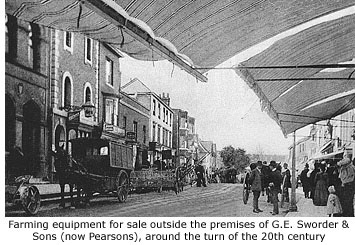 Newspaper advertisements from the 1870s show Sworder's ironmongery store selling modern furniture, carpets, wallpaper and farm machinery – including reaping and mowing machines, horse rakes, corn and manure drills, carts and wagons. Unhindered by traffic at that time, farm machinery was regularly displayed at the roadside outside his North Street premises (see photograph). In 1879 he took into partnership his three sons – George, Arthur, and Herbert – changing the firm's name to G E Sworder & Sons. The 1881 census records him as 'Auctioneer Upholsterer &c', and of his children, two of his sons were Auctioneer[s], another an Ironmonger & Upholsterer, and the two daughters, Alice and Ellen, were Auctioneer daughter[s]. Newspaper advertisements from the 1870s show Sworder's ironmongery store selling modern furniture, carpets, wallpaper and farm machinery – including reaping and mowing machines, horse rakes, corn and manure drills, carts and wagons. Unhindered by traffic at that time, farm machinery was regularly displayed at the roadside outside his North Street premises (see photograph). In 1879 he took into partnership his three sons – George, Arthur, and Herbert – changing the firm's name to G E Sworder & Sons. The 1881 census records him as 'Auctioneer Upholsterer &c', and of his children, two of his sons were Auctioneer[s], another an Ironmonger & Upholsterer, and the two daughters, Alice and Ellen, were Auctioneer daughter[s].
Each Census records George Edward Sworder living at North Street (possibly above the shop at No 17). His status in the community was such that he served on the Local Board from its beginning, and in later years on the Burial Board. He was also a supporter of the Bible Society and Church Missionary Society. After a short illness he died of rheumatic fever 29 March 1884, aged 70. He is buried at New Cemetery, Apton Road. His wife Catherine died in 1902. At his death the Herts & Essex Observer described G E Sworder & Sons, as 'a household name for all that was honest, upright and straightforward'. Several other Sworders were at various times described as auctioneers or valuers, or both, but George Edward and his offspring seem to be the only ones involved with Bishop's Stortford, and whose name will forever be associated with the town.
SEE SEPARATE PIECE ABOUT THE SWORDER FAMILY NAME, BELOW
George's sons continued to run the ironmongery shop at No 17a, as well as the more lucrative estate agent and auctioneering part of the business housed in No 17. After the death of the eldest brother, George Waller, in 1904 the remaining brothers then sold the ironmongery to Sworder's chief clerk, Henry Sparrow. The shop was renamed H Sparrow that same year but in 1915 became H Sparrow Ltd. At some point the Sworder's business moved out and the ironmongery was extended to take in both premises – No 17 & 17a.
Originally from Weybridge in Surrey, Henry Sparrow moved to Windhill, Bishop's Stortford in the mid to late 1800s where he and his wife raised eight children. One of his sons, Alfred (b.1881), joined the business shortly after 1904 and in 1906 married Ada Bugg from Colchester, Essex. Their only child, a daughter, died aged 10.
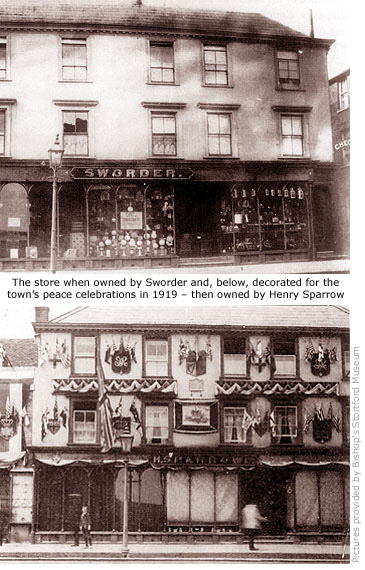 Alfred ran the shop for his father during the First World War – while also serving in the local Home Guard – eventually taking over the running of the business with two of his brothers, Arthur and Herbert. When Arthur died in 1931, Herbert conveyed the business to Lionel Sparrow and Robert Trigg. They were joined by their respective sons, Geoffrey and Peter. The leasehold later passed to Alfred's nephew John Sparrow and his wife Violet, but when Alfred – the last surviving son of Henry Sparrow – died on 30 January 1971, heavy death duties forced the sale of the business. Alfred ran the shop for his father during the First World War – while also serving in the local Home Guard – eventually taking over the running of the business with two of his brothers, Arthur and Herbert. When Arthur died in 1931, Herbert conveyed the business to Lionel Sparrow and Robert Trigg. They were joined by their respective sons, Geoffrey and Peter. The leasehold later passed to Alfred's nephew John Sparrow and his wife Violet, but when Alfred – the last surviving son of Henry Sparrow – died on 30 January 1971, heavy death duties forced the sale of the business.
On 30 September that same year the store and associated properties, including land in Basbow Lane, were sold at auction in two lots by, ironically, auctioneers G E Sworder & Sons. The store was bought for £77,500 by independently owned business, Pearsons (of Enfield), and the Basbow Lane properties went to a local developer for £12,500.
Still trading under the name H Sparrow, the store finally closed for business on Saturday 2 October 1971. Pearsons re-opened it early the following year and have since modernised and greatly expanded the property to make it one of Bishop's Stortford's largest department stores. MORE PICTURES
Much of the above information regarding the Sworder and Summers families is thanks to John Parker. He, like the Sworder family, is descended from a dynasty of wealthy Hertfordshire yeoman farmers who made it common practice to marry into other yeomen farmer families (or their social equivalents). While researching his family history, Mr Parker has identified 13 families (including his own and the Sworders) between whom there were at least 35 marriages. The following information about the Sworder name and family is from primary sources, and is also courtesy of John Parker.
Sworder is not a common name. In the 1881 Census, and excluding married women whose maiden surnames would have been different, there were just 50 adults (ie 21 or older) with that surname recorded in the whole of Great Britain. 45 of the 50, including George Edward, were demonstrably descended from Edmund Sworder (1678 – ?) of Little Hadham.
The Penguin Dictionary of Surnames states that 'Sworder' is an occupational surname deriving from Old English and meaning 'sword maker' and adds that it is a 'Herts-Essex surname'. P H Reaney's magisterial Dictionary of British Surnames says that one Walter le Sorder is mentioned in a Sussex deed of 1324 and that Richard Swordere and John Swerdere are mentioned in a document (apparently relating to Essex) of 1354. He agrees with the Penguin Dictionary about the etymology and meaning of the name.
The line of descent from Edmund is as follows. For each individual I am assuming that the place where his children were christened is the place where he lived. (In some cases this can be confirmed from Wills.)
Edmund lived at Little Hadham. He had four sons, including John, and a daughter.
John (1719–1800) lived at Much Hadham. He had five sons, including William, and four daughters.
William (1754–1830) lived at St Ippollits. He had two sons, William and John.
William (1788–1857) lived at Stocking Pelham. He had nine children, including George Edward (1814–1884).
George Edward had eight siblings, three of whom married three first cousin siblings, children of the younger John.
When the younger William made his Will in 1847, 10 years before he died, all his children were living. The Will recites that he had advanced £4,578 to his eldest son, £1,667 to George Edward, £600 to each of his two married daughters, and £3,484 to his third son. He made specific bequests of £1,000 to each of the four sons and for the remainder of his estate to be divided equally between all nine children. If the eldest son's share of the remainder fell short of £4,578, then the deficiency was to be deducted from his legacy of £1,000. If my arithmetic and interpretation of the Will are both correct, it would seem that he expected his estate to amount to more than £50,000, quite a tidy sum for those days.
John Parker
|
|
|
|
|
|
|
|
|
|
|
|
|
|
|
|
|
|




 The name and sign 'Chequers' apparently originated in ancient Rome: a chequer board outside a bar indicating that banking services were also provided. The checked board was used to aid counting and is the origin of the word 'exchequer.' Appropriately, the Chequers was used as an Excise Office in 1867. Now a Grade II listed building, the inside still retains some fine 17th century work.
The name and sign 'Chequers' apparently originated in ancient Rome: a chequer board outside a bar indicating that banking services were also provided. The checked board was used to aid counting and is the origin of the word 'exchequer.' Appropriately, the Chequers was used as an Excise Office in 1867. Now a Grade II listed building, the inside still retains some fine 17th century work. A meeting in the hotel shortly after it opened in 1874 led to the formation of Bishop's Stortford Football Club; their first match being played two weeks later against the East of England Nonconformist Grammar School - now the Bishop's Stortford College. Between 1903 and 1939 the club used the Falcon public house at Dane Street as their headquarters, but in 1939 re-adopted the Chequers and stayed until after the war when their own club house was built at Rhodes Avenue.
A meeting in the hotel shortly after it opened in 1874 led to the formation of Bishop's Stortford Football Club; their first match being played two weeks later against the East of England Nonconformist Grammar School - now the Bishop's Stortford College. Between 1903 and 1939 the club used the Falcon public house at Dane Street as their headquarters, but in 1939 re-adopted the Chequers and stayed until after the war when their own club house was built at Rhodes Avenue. This early 18th century building was built as two properties, a fact not easily recognised at ground level because of the large shop frontage with original Victorian ironwork and two separate entrances. It is more apparent from the photograph on the left – the right-hand side of the building noticeably larger with six upstairs windows, and the dividing wall between the two properties falling roughly where the sign is placed between windows on the first floor. Until the turn of the 19th century the larger part of this building was the White Lion Inn and stands on the site of a 17th century inn going by the same name. Churchwardens' accounts of 1681 record that Elizabeth Phillips paid rent of 1d for the White Lion in Northstrete [sic].
This early 18th century building was built as two properties, a fact not easily recognised at ground level because of the large shop frontage with original Victorian ironwork and two separate entrances. It is more apparent from the photograph on the left – the right-hand side of the building noticeably larger with six upstairs windows, and the dividing wall between the two properties falling roughly where the sign is placed between windows on the first floor. Until the turn of the 19th century the larger part of this building was the White Lion Inn and stands on the site of a 17th century inn going by the same name. Churchwardens' accounts of 1681 record that Elizabeth Phillips paid rent of 1d for the White Lion in Northstrete [sic]. Newspaper advertisements from the 1870s show Sworder's ironmongery store selling modern furniture, carpets, wallpaper and farm machinery – including reaping and mowing machines, horse rakes, corn and manure drills, carts and wagons. Unhindered by traffic at that time, farm machinery was regularly displayed at the roadside outside his North Street premises (see photograph). In 1879 he took into partnership his three sons – George, Arthur, and Herbert – changing the firm's name to G E Sworder & Sons. The 1881 census records him as 'Auctioneer Upholsterer &c', and of his children, two of his sons were Auctioneer[s], another an Ironmonger & Upholsterer, and the two daughters, Alice and Ellen, were Auctioneer daughter[s].
Newspaper advertisements from the 1870s show Sworder's ironmongery store selling modern furniture, carpets, wallpaper and farm machinery – including reaping and mowing machines, horse rakes, corn and manure drills, carts and wagons. Unhindered by traffic at that time, farm machinery was regularly displayed at the roadside outside his North Street premises (see photograph). In 1879 he took into partnership his three sons – George, Arthur, and Herbert – changing the firm's name to G E Sworder & Sons. The 1881 census records him as 'Auctioneer Upholsterer &c', and of his children, two of his sons were Auctioneer[s], another an Ironmonger & Upholsterer, and the two daughters, Alice and Ellen, were Auctioneer daughter[s]. Alfred ran the shop for his father during the First World War – while also serving in the local Home Guard – eventually taking over the running of the business with two of his brothers, Arthur and Herbert. When Arthur died in 1931, Herbert conveyed the business to Lionel Sparrow and Robert Trigg. They were joined by their respective sons, Geoffrey and Peter. The leasehold later passed to Alfred's nephew John Sparrow and his wife Violet, but when Alfred – the last surviving son of Henry Sparrow – died on 30 January 1971, heavy death duties forced the sale of the business.
Alfred ran the shop for his father during the First World War – while also serving in the local Home Guard – eventually taking over the running of the business with two of his brothers, Arthur and Herbert. When Arthur died in 1931, Herbert conveyed the business to Lionel Sparrow and Robert Trigg. They were joined by their respective sons, Geoffrey and Peter. The leasehold later passed to Alfred's nephew John Sparrow and his wife Violet, but when Alfred – the last surviving son of Henry Sparrow – died on 30 January 1971, heavy death duties forced the sale of the business.